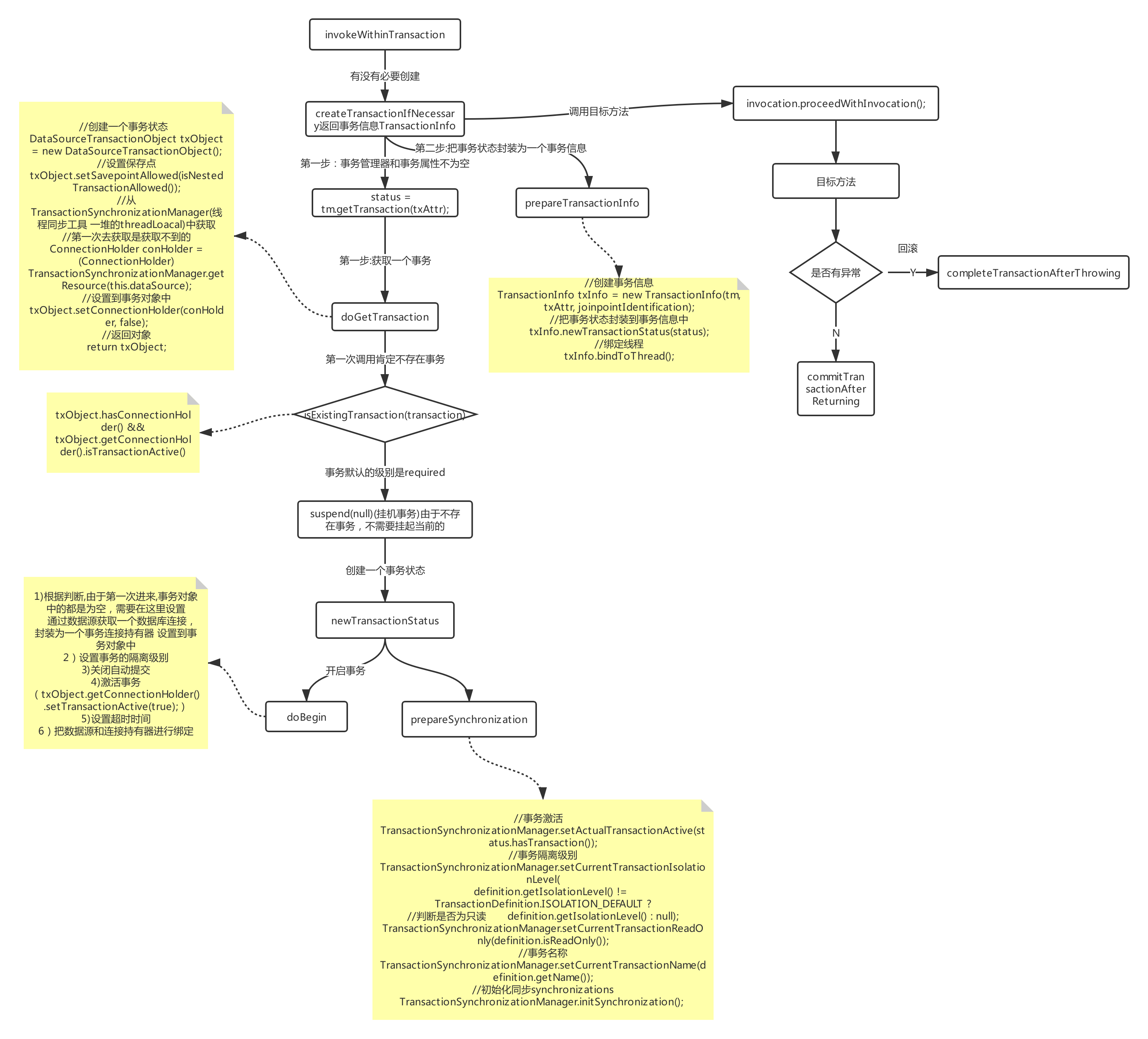Spring事务源码(四)
一、开始

二、源码分析
org.springframework.transaction.interceptor.TransactionInterceptor#invoke(事务拦截器进行调用)
public Object invoke(final MethodInvocation invocation) throws Throwable {
//获取代理对象的目标class
Class<?> targetClass = (invocation.getThis() != null ? AopUtils.getTargetClass(invocation.getThis()) : null);
//使用事务调用
return invokeWithinTransaction(invocation.getMethod(), targetClass, new InvocationCallback() {
//从这里触发调用目标方法的
public Object proceedWithInvocation() throws Throwable {
return invocation.proceed();
}
});
}
org.springframework.transaction.interceptor.TransactionAspectSupport#invokeWithinTransaction(事务调用)
protected Object invokeWithinTransaction(Method method, Class<?> targetClass, final InvocationCallback invocation)
throws Throwable {
//通过@EnableTransactionManager 到入了TransactionAttributeSource 可以获取出事务属性对象,前面匹配增强器时,已放入缓存
final TransactionAttribute txAttr = getTransactionAttributeSource().getTransactionAttribute(method, targetClass);
//获取工程中的事务管理器
final PlatformTransactionManager tm = determineTransactionManager(txAttr);
//获取我们需要切入的方法(也就是我们标识了@Transactional注解的方法),可从txAttr中获取
final String joinpointIdentification = methodIdentification(method, targetClass, txAttr);
//再这里我们只看我们常用的事务管理器,很明显我们不会配置CallbackPreferringPlatformTransactionManager事务管理器
if (txAttr == null || !(tm instanceof CallbackPreferringPlatformTransactionManager)) {
//判断有没有必要开启事务
TransactionInfo txInfo = createTransactionIfNecessary(tm, txAttr, joinpointIdentification);
Object retVal = null;
try {
//调用我们的目标方法
retVal = invocation.proceedWithInvocation();
}
catch (Throwable ex) {
//抛出异常进行回顾
completeTransactionAfterThrowing(txInfo, ex);
throw ex;
}
finally {
//清除事务信息
cleanupTransactionInfo(txInfo);
}
//提交事务
commitTransactionAfterReturning(txInfo);
return retVal;
}
}
org.springframework.transaction.interceptor.TransactionAspectSupport#createTransactionIfNecessary
protected TransactionInfo createTransactionIfNecessary(
PlatformTransactionManager tm, TransactionAttribute txAttr, final String joinpointIdentification) {
//把事务属性包装为
if (txAttr != null && txAttr.getName() == null) {
txAttr = new DelegatingTransactionAttribute(txAttr) {
@Override
public String getName() {
return joinpointIdentification;
}
};
}
TransactionStatus status = null;
if (txAttr != null) {
if (tm != null) {
//获取一个事务状态
status = tm.getTransaction(txAttr);
}
else {
if (logger.isDebugEnabled()) {
logger.debug("Skipping transactional joinpoint [" + joinpointIdentification +
"] because no transaction manager has been configured");
}
}
}
//准备事务信息
return prepareTransactionInfo(tm, txAttr, joinpointIdentification, status);
}
org.springframework.transaction.support.AbstractPlatformTransactionManager#getTransaction
public final TransactionStatus getTransaction(TransactionDefinition definition) throws TransactionException {
//1:)先去尝试开启一个事务
Object transaction = doGetTransaction();
// Cache debug flag to avoid repeated checks.
boolean debugEnabled = logger.isDebugEnabled();
//传入进来的事务定义为空
if (definition == null) {
//使用系统默认的
definition = new DefaultTransactionDefinition();
}
//2:)//判断是否存在事务(若存在事务,在这边直接返回不走下面的处理了)
if (isExistingTransaction(transaction)) {
// Existing transaction found -> check propagation behavior to find out how to behave.
return handleExistingTransaction(definition, transaction, debugEnabled);
}
//3:)判读事务超时
if (definition.getTimeout() < TransactionDefinition.TIMEOUT_DEFAULT) {
throw new InvalidTimeoutException("Invalid transaction timeout", definition.getTimeout());
}
//不存在事务,需要在这边判断(PROPAGATION_MANDATORY 标识要求当前允许的在事务中,但是第二步进行判断之后 说明这里没有事务)
if (definition.getPropagationBehavior() == TransactionDefinition.PROPAGATION_MANDATORY) {
throw new IllegalTransactionStateException(
"No existing transaction found for transaction marked with propagation 'mandatory'");
}
//PROPAGATION_REQUIRED
//PROPAGATION_REQUIRES_NEW
//PROPAGATION_NESTED
else if (definition.getPropagationBehavior() == TransactionDefinition.PROPAGATION_REQUIRED ||
definition.getPropagationBehavior() == TransactionDefinition.PROPAGATION_REQUIRES_NEW ||
definition.getPropagationBehavior() == TransactionDefinition.PROPAGATION_NESTED) {
//挂起当前事务,但是当前是没有事务的
SuspendedResourcesHolder suspendedResources = suspend(null);
if (debugEnabled) {
logger.debug("Creating new transaction with name [" + definition.getName() + "]: " + definition);
}
try {
boolean newSynchronization = (getTransactionSynchronization() != SYNCHRONIZATION_NEVER);
//创建一个新的事物状态
DefaultTransactionStatus status = newTransactionStatus(
definition, transaction, true, newSynchronization, debugEnabled, suspendedResources);
//开启一个事物
doBegin(transaction, definition);
//准备事物同步
prepareSynchronization(status, definition);
return status;
}
catch (RuntimeException ex) {
resume(null, suspendedResources);
throw ex;
}
catch (Error err) {
resume(null, suspendedResources);
throw err;
}
}
else {
//创建一个空的事物.
if (definition.getIsolationLevel() != TransactionDefinition.ISOLATION_DEFAULT && logger.isWarnEnabled()) {
logger.warn("Custom isolation level specified but no actual transaction initiated; " +
"isolation level will effectively be ignored: " + definition);
}
boolean newSynchronization = (getTransactionSynchronization() == SYNCHRONIZATION_ALWAYS);
return prepareTransactionStatus(definition, null, true, newSynchronization, debugEnabled, null);
}
}
doGetTransaction
/**
* 第一次进来的时候,是没有事务持有对象
* */
protected Object doGetTransaction() {
//创建一个数据库事务管理器
DataSourceTransactionObject txObject = new DataSourceTransactionObject();
//设置一个事务保存点
txObject.setSavepointAllowed(isNestedTransactionAllowed());
//从事务同步管理器中获取连接持有器
ConnectionHolder conHolder =
(ConnectionHolder) TransactionSynchronizationManager.getResource(this.dataSource);
//把持有器设置到对象中
txObject.setConnectionHolder(conHolder, false);
//返回一个事务对象
return txObject;
}
isExistingTransaction
//第一次进来不会走这个逻辑
protected boolean isExistingTransaction(Object transaction) {
//获取事务对象中的持有器
DataSourceTransactionObject txObject = (DataSourceTransactionObject) transaction;
//持有器不为空且 有事务激活
return (txObject.hasConnectionHolder() && txObject.getConnectionHolder().isTransactionActive());
}
doBegin
/**
* 第一次调用的时候
* */
protected void doBegin(Object transaction, TransactionDefinition definition) {
DataSourceTransactionObject txObject = (DataSourceTransactionObject) transaction;
Connection con = null;
try {
//第一次进来,事务持有器中是没有对象的,所以我们需要自己手动的设置进去
if (!txObject.hasConnectionHolder() ||
txObject.getConnectionHolder().isSynchronizedWithTransaction()) {
//获取一个数据库连接
Connection newCon = this.dataSource.getConnection();
if (logger.isDebugEnabled()) {
logger.debug("Acquired Connection [" + newCon + "] for JDBC transaction");
}
//把数据库连接封装为一个持有器对象并且设置到事务对象中
txObject.setConnectionHolder(new ConnectionHolder(newCon), true);
}
/开始同步标志
txObject.getConnectionHolder().setSynchronizedWithTransaction(true);
con = txObject.getConnectionHolder().getConnection();
//获取事务的隔离级别
Integer previousIsolationLevel = DataSourceUtils.prepareConnectionForTransaction(con, definition);
txObject.setPreviousIsolationLevel(previousIsolationLevel);
/**
* 关闭事务自动提交
* */
if (con.getAutoCommit()) {
txObject.setMustRestoreAutoCommit(true);
if (logger.isDebugEnabled()) {
logger.debug("Switching JDBC Connection [" + con + "] to manual commit");
}
con.setAutoCommit(false);
}
//判断事务是不是为只读的事务
prepareTransactionalConnection(con, definition);
//设置事务激活
txObject.getConnectionHolder().setTransactionActive(true);
int timeout = determineTimeout(definition);
if (timeout != TransactionDefinition.TIMEOUT_DEFAULT) {
txObject.getConnectionHolder().setTimeoutInSeconds(timeout);
}
//把数据源和事务持有器保存到事务同步管理器中
if (txObject.isNewConnectionHolder()) {
TransactionSynchronizationManager.bindResource(getDataSource(), txObject.getConnectionHolder());
}
}
catch (Throwable ex) {
if (txObject.isNewConnectionHolder()) {
//抛出异常,释放资源
DataSourceUtils.releaseConnection(con, this.dataSource);
txObject.setConnectionHolder(null, false);
}
throw new CannotCreateTransactionException("Could not open JDBC Connection for transaction", ex);
}
}
prepareSynchronization把当前的事务设置到同步管理器中
protected void prepareSynchronization(DefaultTransactionStatus status, TransactionDefinition definition) {
if (status.isNewSynchronization()) {
//设置事务激活
TransactionSynchronizationManager.setActualTransactionActive(status.hasTransaction());
//设置隔离级别
TransactionSynchronizationManager.setCurrentTransactionIsolationLevel(
definition.getIsolationLevel() != TransactionDefinition.ISOLATION_DEFAULT ?
definition.getIsolationLevel() : null);
//设置只读书屋
ransactionSynchronizationManager.setCurrentTransactionReadOnly(definition.isReadOnly());
//设置事务的名称
TransactionSynchronizationManager.setCurrentTransactionName(definition.getName());
TransactionSynchronizationManager.initSynchronization();
}
}
prepareTransactionInfo准备事务信息
protected TransactionInfo prepareTransactionInfo(PlatformTransactionManager tm,
TransactionAttribute txAttr, String joinpointIdentification, TransactionStatus status) {
//把事务管理器,事务属性,连接点信息封装成为TransactionInfo
TransactionInfo txInfo = new TransactionInfo(tm, txAttr, joinpointIdentification);
if (txAttr != null) {
// We need a transaction for this method...
if (logger.isTraceEnabled()) {
logger.trace("Getting transaction for [" + txInfo.getJoinpointIdentification() + "]");
}
//设置事务状态
txInfo.newTransactionStatus(status);
}
else {
// The TransactionInfo.hasTransaction() method will return false. We created it only
// to preserve the integrity of the ThreadLocal stack maintained in this class.
if (logger.isTraceEnabled())
logger.trace("Don't need to create transaction for [" + joinpointIdentification +
"]: This method isn't transactional.");
}
//把事务信息绑定到当前线程上去
txInfo.bindToThread();
return txInfo;
}
三、结束、事务源码分析就到这里,希望对你有所帮助。